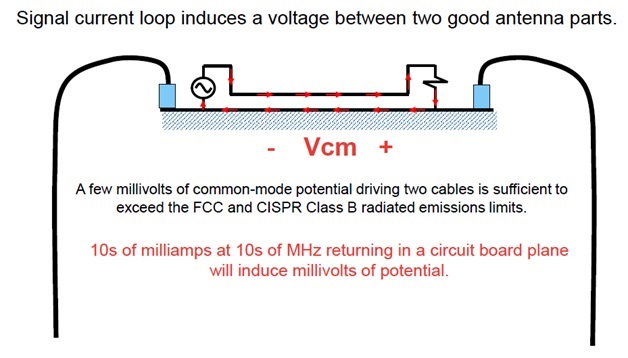If its day one at the annual IEEE EMC Symposium, it’s an occasion to firm up your understanding and attend tutorials on all things EMC, PI and SI. Even though I’ve been in the industry for almost 40 years, I still learn something new whenever I listen to experts teach these topics. In particular, I learned a lot from Todd Hubing’s presentation on Grounding.
Todd is a Professor Emeritus at Clemson University, and has started his own training company, LearnEMC. He has transformed his many years of expertise as both an EMC engineer and a professor into an on-line learning experience, well worth a visit.
At the 2017 EMC Symposium, he presented a lecture on Grounding, ranking neck-and-neck with inductance as the most confusing and most important topic spanning the three areas of EMC, PI and SI.
“Ground is NOT a current return path,” is the most important message of his presentation. “Ground is a conductor that serves as a reference potential to measure other voltages, and does not carry current.” If you keep this idea at the forefront, Todd says, it will eliminate most of the confusion about ground and grounding.
This confusion has created a lot of business for EMC consultants, as Tom van Doren’s quote in Figure 1 points out.

Figure 1. Tom van Doren is fond of pointing out many of his consulting jobs have been based on confusion in the industry about ground.
With this distinction in mind, there are two important skills for any EMC engineer: to identify the return paths in a product and to establish an effective grounding strategy.
High frequency currents usually return through the metal adjacent to the signal paths. This means we should all engineer low impedance return paths, like planes, adjacent to all the signal lines. But low frequency return currents care about the resistance of the return path as much as the loop inductance. This means multiple return paths in parallel may provide an unintentional return path for low frequency currents, resulting in a shared common impedance for different signals.
As soon as there is a common impedance through which multiple return currents can flow, there is the chance of a voltage drop from one current appearing as voltage cross talk to another circuit. This is the origin of ground loops and ground bounce noise.
When the same plane used to carry return-current is also connected to the external shield of a coax, it’s possible for the voltage drop on the return plane to act as the voltage source to drive currents in the external shields and suddenly you have created a dipole antenna. Figure 2 shows an example of how this can happen.

Figure 2. How noise in the return path conductor can contribute to radiated emissions on external coax cables.
Todd offers four rules for an effective grounding strategy:
- Designate one location or one non-current-carrying metal structure as your zero-volt reference or ground.
- Be sure that all other metal structures including attached cables and large heatsinks do not deviate from the ground potential by more than an acceptable limit.
- For radiated emissions (10s of MHz and higher), this acceptable limit is on the order of 1 mV.
- For safety, the acceptable limit is generally on the order of 10s of volts.
Todd offered one last parting thought, “Always use a solid ‘ground’ return plane under a split voltage plane.”
You can find more guidance on best design practices for EMC/PI/Si designs on Todd’s web site, LearnEMC.



Recent Comments
Continuation from the previous comment: Also, Electromagnetic Theory...
Mr. Bogatin: I totally agree with you. In...
Such plug fests are required as they allow...
Dear Mr. Bogatin, I greatly enjoyed your article about...
Eric, are you concerned that ML and AI...